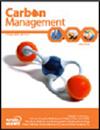通过综合土壤-作物系统管理实现印度东部水稻种植区多样化,以减少温室气体排放和提高生产力
IF 3.2
4区 环境科学与生态学
Q3 ENVIRONMENTAL SCIENCES
引用次数: 1
摘要
单作、秸秆焚烧、施肥不平衡和有机肥利用有限是造成土壤有机碳(SOC)流失的主要原因。本研究通过土壤-作物综合管理(ILMsoil)、改良管理(IMsoil)和常规管理(CMsoil)来增强土壤固碳以减缓温室气体(GHG)排放。采用生命周期评价(LCA)方法对水稻、芥菜和黄麻连作有无间作或混作的碳足迹进行了估算。采用ILMsoil帮助减少了78%的碳足迹。总体经济产量也比IMsoil提高了25%。与其他系统相比,ILMsoil的净co2当量排放量减少68%。黄麻、豆科间作和混作对有机碳的高固碳作用是减少LCA-GHG净排放量的主要原因。改良作物多样化和提高农业生产力可以减少不可再生能源的投入,从而减少农业生态系统的温室气体排放。改善土壤健康、减少养分和水分流失以及增加有机肥的施用有助于减少碳足迹。在70万公顷黄麻种植区采用ILMsoil种植方法,每年可从大气中减少约40万吨二氧化碳当量,并为印度东部农民提供122万美元的碳信用。本文章由计算机程序翻译,如有差异,请以英文原文为准。
Diversification of rice growing areas in Eastern India with integrated soil–crop system management for GHGs mitigation and higher productivity
Abstract Mono-cropping, burning of crop residues, imbalanced fertilization and limited use of farm manure are resulting in loss of soil organic carbon (SOC). In this study, integrated soil-crop management (ILMsoil), improved management (IMsoil) and conventional management (CMsoil) was studied to enhance the soil carbon sequestration for mitigation of greenhouse gas (GHG) emissions. The life cycle assessment (LCA) approach was used to estimate carbon footprint from successive crops of rice, mustard and jute with or without intercrops or mixed crops. The adoption of ILMsoil helped in reducing the carbon footprint by 78%. The overall economic yield increased by 25% over IMsoil as well. Net CO2-eq emission was 68% less under ILMsoil as compared to other systems. The reduction in net LCA-GHG emission was mainly due to high SOC sequestration by jute crop and leguminous intercrops and mixed crops. Improved crop diversification and agronomic productivity as used in ILMsoil system may decrease the inputs of non-renewable energy and consequently reduce the emission of GHGs from agroecosystems. Improvement of soil health, minimization in nutrient and water losses, and application of the increased amount of organic fertilizers were found helpful in reducing the carbon footprint. ILMsoil method of cultivation in 0.70 million hectare of jute growing area may reduce about 0.40 million tonnes of CO2-eq from atmosphere every year and provide carbon credit of 1.22 million US$to the farmers of eastern India.
求助全文
通过发布文献求助,成功后即可免费获取论文全文。
去求助
来源期刊

Carbon Management
ENVIRONMENTAL SCIENCES-
CiteScore
5.80
自引率
3.20%
发文量
35
期刊介绍:
Carbon Management is a scholarly peer-reviewed forum for insights from the diverse array of disciplines that enhance our understanding of carbon dioxide and other GHG interactions – from biology, ecology, chemistry and engineering to law, policy, economics and sociology.
The core aim of Carbon Management is it to examine the options and mechanisms for mitigating the causes and impacts of climate change, which includes mechanisms for reducing emissions and enhancing the removal of GHGs from the atmosphere, as well as metrics used to measure performance of options and mechanisms resulting from international treaties, domestic policies, local regulations, environmental markets, technologies, industrial efforts and consumer choices.
One key aim of the journal is to catalyse intellectual debate in an inclusive and scientific manner on the practical work of policy implementation related to the long-term effort of managing our global GHG emissions and impacts. Decisions made in the near future will have profound impacts on the global climate and biosphere. Carbon Management delivers research findings in an accessible format to inform decisions in the fields of research, education, management and environmental policy.
 求助内容:
求助内容: 应助结果提醒方式:
应助结果提醒方式:


